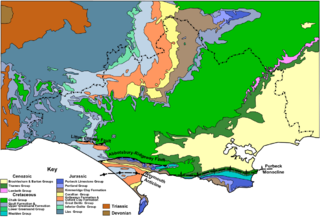Related Research Articles

Dorset is a county in South West England on the English Channel coast. Covering an area of 2,653 square kilometres (1,024 sq mi); it borders Devon to the west, Somerset to the north-west, Wiltshire to the north-east, and Hampshire to the east. The great variation in its landscape owes much to the underlying geology, which includes an almost unbroken sequence of rocks from 200 to 40 million years ago (Mya) and superficial deposits from 2 Mya to the present. In general, the oldest rocks appear in the far west of the county, with the most recent (Eocene) in the far east. Jurassic rocks also underlie the Blackmore Vale and comprise much of the coastal cliff in the west and south of the county; although younger Cretaceous rocks crown some of the highpoints in the west, they are mainly to be found in the centre and east of the county.
The Hesbaye Group is a stratigraphic group in the subsurface of northeastern Belgium. This group was deposited during the early Paleocene epoch and is subdivided into two formations: the Houthem Formation (lower) and the Opglabbeek Formation (upper). The group is named after the region of Hesbaye in the south of Limburg.
The Opglabbeek Formation is a geologic formation in the subsurface of the eastern part of Belgian Limburg. The heterogeneous formation consists of clay and sand that was deposited lagoonally and fluvially during the early Selandian. The formation is named after the town of Opglabbeek in Limburg.
The Hannut Formation is a geologic formation in the subsurface of northern Belgium. The formation consists of marine clay and silt, alternating with more sandy layers. On top of this the lithology changes to limestone, siltstone and sandstone and the top of the formation is formed by a layer of glauconite bearing sand. The Hannut Formation was formed during the early to middle Thanetian age.
The Heers Formation is a geologic formation in the subsurface of Belgium. The formation consists of sand and marl and was deposited in the shallow sea that covered Belgium during the middle to late Selandian age of the Paleocene epoch.
The Landen Group is a lithostratigraphic unit in the Belgian subsurface. The group consists of two formations of Thanetian to Ypresian age. The Landen Group is named after the town of Landen in Flemish Brabant.
The Tienen Formation is a geologic formation in the subsurface of northern Belgium. The formation crops out in the province of Hainaut and the Hesbaye region in the province of Limburg. It has a late Thanetian (Paleocene) to early Ypresian (Eocene) age.
The Ieper Group is a group of rock strata in the subsurface of northwest Belgium. The group is subdivided into three marine formations, all formed during the Ypresian, a single age of the geologic timescale. Both age and group are named after the West Flemish town of Ypres, for which the Dutch name is "Ieper".
The Dongen Formation is a geologic formation in the subsurface of the Netherlands. The formation consists of early Eocene marine clay and sand. It is named after the town of Dongen in North Brabant.
The Rupel Formation is a geologic formation in the subsurface of the Netherlands that consists of Oligocene marine sands and clays. The Rupel Formation is part of the Middle North Sea Group and correlates exactly with the Belgian Rupel Group.
The Rupel Group is a stratigraphic group of rock strata in the subsurface of Belgium. It is subdivided into three formations that are all marine deposits of Oligocene age.
The Tongeren Formation is a geologic formation in the subsurface of the Netherlands. The formation consists of shallow marine, epicontinental and continental sediments, predominantly clay and sand from the late Eocene and early Oligocene epochs. The Tongeren Formation is part of the Middle North Sea Group and correlates with the Tongeren Group from Belgian stratigraphy.
The Aalter Formation is a geologic formation in the subsurface of northwest Belgium. The formation consists of marine clay and sand, deposited in the shallow sea that covered northern and central Belgium in the Eocene epoch.
The Gentbrugge Formation is a geologic formation in the west of Belgium. The formation crops out in East Flanders and West Flanders and also occurs in the subsurface of the Province of Antwerp. It consists of marine clay, silt and sand, deposited in the shallow sea that covered northern Belgium during the Ypresian age.
The Tielt Formation is a geologic formation in the subsurface of Belgium. The formation crops out in the north of Hainaut, in the southern and central parts of West- and East Flanders and in Walloon and Flemish Brabant. It consists of marine very fine sand and silt, deposited in the shallow sea that covered Belgium during the middle and late Ypresian age.
The Kortrijk Formation is a geologic formation in the Belgian subsurface. This formation crops out in northern Hainaut, southern West and East Flanders and in Walloon Brabant. The formation consists of marine clay from the Ypresian age.
The Maldegem Formation is a geologic formation in the Belgian subsurface. The formation consists of alternating marine clay and sand strata, deposited during the late Eocene.
The Brussels Formation is a geologic formation in the subsurface of central Belgium. The formation is named after the Belgian capital, Brussels. It consists of shallow marine sandstone and calcareous sands, deposited in the sea that covered Belgium 45 million years ago, in the Eocene.
The Lede Formation is a geologic formation in the subsurface of Belgium. The formation is named after the town of Lede in East Flanders. It consists of shallow-marine limestone and sandstone, deposited in the former sea that covered Belgium during the Eocene.
The Tongeren Group is a lithostratigraphic unit in the subsurface of Belgium. It consists of shallow marine, epicontinental and/or continental clays and sands from the late Eocene to early Oligocene epochs.
References
- Laga, P.; Louwye, S. & Geets, S. (eds.); 2001: Paleogene and Neogene lithostratigraphic units (Belgium), Geologica Belgica 4(1-2), p. 135-152